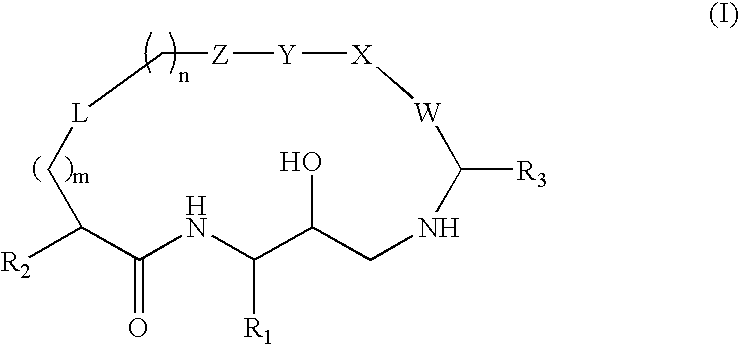Diaminopropane derived macrocycles as inhibitors of beta amyloid production
a technology of diaminopropane and macrocycle, which is applied in the field of macrocycle diaminopropane compounds, can solve the problems of affecting the productivity of patients and caregivers, the suffering of patients, and the suffering of families, and achieves the effects of caregivers, and reducing the burden on patients
- Summary
- Abstract
- Description
- Claims
- Application Information
AI Technical Summary
Benefits of technology
Problems solved by technology
Method used
Image
Examples
preparation b
(2S)-2-(2-ethyl-N-methylhexanamido)pent-4-enoic acid (diastereomer A)
and
[0115]
(2S)-2-(2-ethyl-N-methylhexanamido)pent-4-enoic acid (diastereomer B)
[0116]
[0117]Step B (1): Same procedure as Step A (1). 2-Ethylhexanoic acid was used in place of 2-propylpentanoic acid. The crude reaction products were purified by silica-gel column chromatography to give 258 mg (33% yield) of diastereomer A and 284 mg (37% yield) of diastereomer B of (2S)-methyl 2-(2-ethylhexanamido)pent-4-enoate. Data for diasteromer A: LC-MS (M+H)+=256.16, 1H NMR (300 MHz, CDCl3) δ 0.76-0.93 (m, 5H) 1.11-1.66 (m, 10H) 1.87-2.00 (m, 1H) 2.41-2.63 (m, 2H) 3.72 (s, 3H) 4.66-4.77 (m, 1H) 5.03-5.14 (m, 2H) 5.55-5.72 (m, 1H) 5.91 (d, J=7.32 Hz, 1H). Data for diastereomer B: LC-MS (M+H)+=256.17, 1H NMR (300 MHz, CDCl3) δ ppm 0.77-0.93 (m, 5H) 1.14-1.65 (m, 10H) 1.87-2.00 (m, 1H) 2.41-2.66 (m, 2H) 3.72 (s, 3H) 4.64-4.77 (m, 1H) 5.01-5.16 (m, 2H) 5.56-5.72 (m, 1H) 5.90 (d, J=7.68 Hz, 1H).
[0118]Step B (2): Same procedure as Ste...
preparation d
(S)-2-((S)-N,2-dimethylhexanamido)pent-4-enoic acid (diastereomer A)
[0124]
and
(S)-2-((R)-N,2-dimethylhexanamido)pent-4-enoic acid (diastereomer B)
[0125]
[0126]Step D (1): Same procedure as step A (1). 2-Methylhexanoic acid was used in place of 2-propylpentanoic acid. The crude products were purified using silica gel chromatography (EtOAc / hexanes, 1-50% linear gradient) to afford 484 mg (33% yield) of (S)-methyl 2-((S)-2-methylhexanamido)pent-4-enoate (diastereomer A, first to elute) as a white solid and 526 mg (36% yield) of (S)-methyl 2-((R)-2-methylhexanamido)pent-4-enoate (diastereomer B, second to elute) as a white solid. Data for diastereomer A: LRMS (M−H)−=240.0; [α]D +27.4 (c=10.2 mg / mL, dichloroethane). 1H NMR (500 MHz, CDCl3) δ ppm 0.87 (t, J=7.02 Hz, 3H) 1.07-1.16 (m, 3H) 1.21-1.41 (m, 5H) 1.56-1.67 (m, 1H) 2.15-2.25 (m, 1H) 2.44-2.52 (m, 1H) 2.56-2.65 (m, 1H) 3.74 (s, 3H) 4.64-4.73 (m, 1H) 5.06-5.18 (m, 2H) 5.60-5.72 (m, 1H) 5.92 (d, J=6.71 Hz, 1H). Data for diastereomer B:...
preparation ai
(5-methyl-2-(pent-4-enyl)phenyl)methanamine
[0257]
[0258]Step AI (1): To a solution of 2-bromo-5-methylbenzoic acid (1000.0 mg, 4.65 mmol) in DMF (100 mL) were added N,O-dimethylhydroxylamine hydrochloride (454 mg, 4.65 mmol), EDC (891 mg, 4.65 mmol), and HOBT (628 mg, 4.65 mmol). The reaction mixture was stirred at rt for 2.5 days. The reaction mixture was diluted with water and extracted with EtOAc. The combined organic phases were dried over Na2SO4, filtered and concentrated in vacuum. The residue was purified by silica gel chromatography to give 2-bromo-N-methoxy-N,5-dimethylbenzamide (656 mg, 55%) as a colorless oil. LC-MS (M+H)+=258.21.
[0259]Step AI (2): 2-Bromo-N-methoxy-N,5-dimethylbenzamide (656 mg, 2.54 mmol) was dissolved in THF (20 mL). The reaction mixture was cooled down to −78° C. and a 1.0M solution of DIBAL-H (7.62 mL, 7.62 mmol) was added. The reaction mixture was stirred at −78° C. for 1 h. The reaction was quenched with acetone and stirred at rt with Rochelle's sal...
PUM
 Login to View More
Login to View More Abstract
Description
Claims
Application Information
 Login to View More
Login to View More - R&D
- Intellectual Property
- Life Sciences
- Materials
- Tech Scout
- Unparalleled Data Quality
- Higher Quality Content
- 60% Fewer Hallucinations
Browse by: Latest US Patents, China's latest patents, Technical Efficacy Thesaurus, Application Domain, Technology Topic, Popular Technical Reports.
© 2025 PatSnap. All rights reserved.Legal|Privacy policy|Modern Slavery Act Transparency Statement|Sitemap|About US| Contact US: help@patsnap.com



